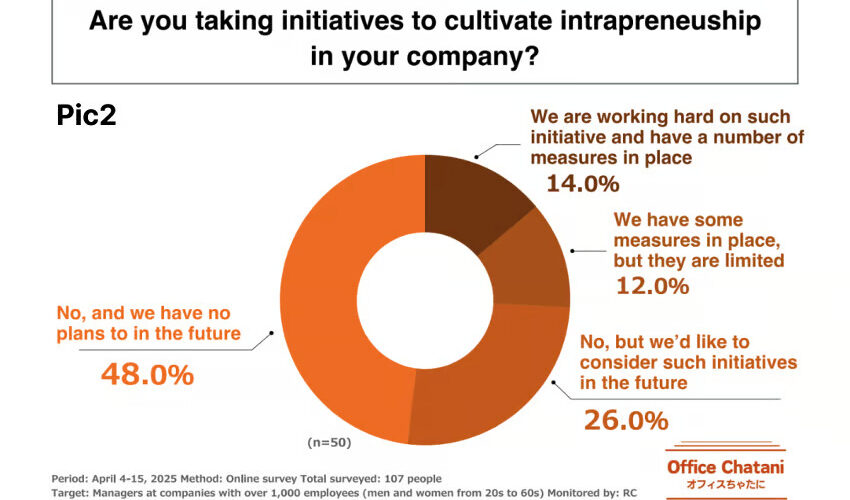A new survey by Office Chatani, Inc. sheds light on the state of intrapreneurship in large Japanese corporations, revealing both a strong appetite for internal innovation – and the cultural and structural roadblocks that often prevent it.
The study conducted in April 2025, targeted over 100 managers at companies with more than 1,000 employees. It explored the presence of “intrapreneurs” – employees who create new business ventures within their companies – and examined the key traits that define them, the internal conditions that help them thrive and the reasons many companies still struggle to develop them.
What Are Japan’s Intrapreneurs?
Among the companies surveyed, over 50% reported having intrapreneurs in their workforce. The largest age group among these innovators was between 40 and 49 years old, suggesting that career experiences plays a role in navigating internal systems while pushing boundaries.
The three most commonly shared traits among intrapreneurs were:
- Creativity and imagination
- Business strategy acumen
- Autonomy and independent action
These skills not only reflect the need for original thinking, but also the capacity to understand market dynamics and take calculated risks within a corporate environment.
Culture Is the Game-Changer
When asked what enables entrepreneurs to succeed, nearly 20% of respondents pointed to “a corporate culture that is tolerant of new challenges” – the top-ranked factor. Support from management and reward systems tied for second place.
Intrapreneurs thrive where bold ideas aren’t punished, and where internal systems allow room for experimentation, failure, and long-term thinking. Without cultural support, even the most creative employees struggle to move ideas forward.
For Companies Without Intrapreneurs: A Wake-Up Call
The study also revealed that more than 70% of companies without intrapreneurs are not currently taking steps to develop them. Of those, nearly half admitted they had no intention to do so in the future — a worrying indicator for companies hoping to stay competitive in today’s VUCA (volatile, uncertain, complex, ambiguous) world.
For the minority of companies trying to change that, the most common development initiative was “providing training and educational opportunities for new business”, followed by efforts to encourage interdepartmental collaboration and restructure internal systems.
But even those trying to build innovation from within face obstacles. The top three challenges reported were:
- Lack of role models within the company
- Lack of internal resources (time, budget, personnel)
- Lack of systems to evaluate or reward innovation efforts
These barriers highlight the gap between intent and implementation – and emphasize the need for leadership to model and enable risk-taking behaviors from the top down.
Office Chatani’s Perspective
With creativity topping the list of desired traits, Office Chatani, Inc. is focused on helping companies overcome the structural inertia that blocks innovation. The company offers management support services designed to cultivate creative human resources and align internal systems with long-term value creation.
This latest survey builds on insights from Part 1 and positions Office Chatani as a key player in understanding the future of work and intrapreneurship in Japan.
Final Takeaway
Intrapreneurs are not rare anomalies – they already exist within many large organisations. However, without the right organisational culture, structural support and leadership alignment, their potential remains underutilised. This survey underscores the importance of building internal environments that nurture creative thinking, cross-functional collaboration and long-term innovation capacity. The development of intrapreneurship is not solely about identifying individuals with unique traits, but about creating the conditions in which they can thrive.









